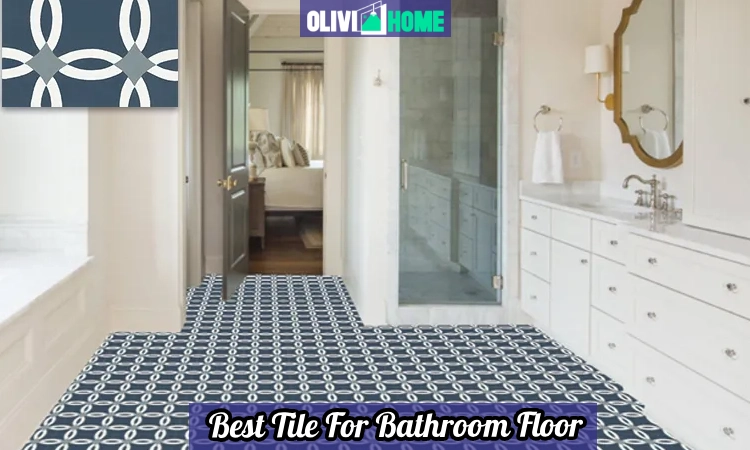Bathroom flooring is a crucial element in the design and functionality of any bathroom. It must withstand moisture, provide safety, and complement the overall aesthetic of the space. With numerous options available, selecting the best tile for your bathroom floor can be overwhelming. This guide explores the top materials, trends, and considerations to help you make an informed decision.
Key Considerations for Bathroom Floor Tiles
Before diving into specific tile types, it’s essential to understand the factors that make a tile suitable for bathroom floors:
- Water Resistance: Bathrooms are exposed to high levels of moisture. Tiles must be water-resistant to prevent damage and ensure longevity.
- Durability: Bathroom floors endure frequent foot traffic and potential impacts. Durable materials are essential to avoid cracks or wear.
- Slip Resistance: Safety is paramount in wet areas. Tiles with textured surfaces or smaller formats with more grout lines provide better grip.
- Ease of Maintenance: Tiles should be easy to clean and resistant to stains or mold.
- Aesthetic Appeal: The tile should complement your bathroom’s design while reflecting your personal style.
Popular Tile Materials for Bathroom Floors
Porcelain Tiles
Porcelain tiles are a top choice for bathroom floors due to their durability, water resistance, and versatility. Made from dense clay fired at high temperatures, porcelain tiles are non-porous and can withstand heavy use.
- Advantages: Extremely durable, low maintenance, waterproof, and available in various colors and textures.
- Disadvantages: More expensive than ceramic tiles and harder to cut during installation.
- Best Use: High-traffic bathrooms, shower floors, and areas prone to water exposure.
Ceramic Tiles
Ceramic tiles are similar to porcelain but less dense, making them easier to cut and install. They are a budget-friendly option with a wide range of designs.
- Advantages: Affordable, easy to install, available in diverse patterns and colors.
- Disadvantages: Less durable than porcelain and more prone to water absorption.
- Best Use: Low-traffic bathrooms or decorative flooring.
Natural Stone Tiles
Stone tiles such as slate, marble, or travertine add a luxurious touch to bathrooms. These tiles are naturally beautiful but require sealing to enhance water resistance.
- Advantages: Unique aesthetics, durable when sealed properly.
- Disadvantages: Expensive, requires regular maintenance, can be slippery if polished.
- Best Use: High-end bathroom designs or spa-inspired spaces.
Vinyl Tiles
Vinyl tiles have gained popularity due to their affordability and practicality. They mimic the appearance of natural materials like wood or stone.
- Advantages: Waterproof, comfortable underfoot, budget-friendly.
- Disadvantages: Less eco-friendly and may warp over time if not installed properly.
- Best Use: Family bathrooms or budget-conscious renovations.
Mosaic Tiles
Mosaic tiles are small tiles often made from ceramic, glass, or stone. They are ideal for creating intricate designs or adding texture.
- Advantages: Slip-resistant due to numerous grout lines, highly customizable.
- Disadvantages: Labor-intensive installation process.
- Best Use: Shower floors or accent areas.
Top Bathroom Tile Trends for 2025
The year 2025 brings exciting trends in bathroom flooring that combine functionality with cutting-edge design:
Bold Colors
Vibrant hues like deep blues, terra-cotta reds, and jewel tones are replacing neutral palettes. These bold choices create a striking visual impact while adding personality to the space.
Large Format Tiles
Large-format tiles reduce grout lines for a sleek and modern look. They make small bathrooms appear more spacious by creating a seamless surface.
Textured Surfaces
Textured tiles add depth and grip to bathroom floors. Options like limestone-inspired finishes provide both style and safety.
Geometric Patterns
Hexagons, chevrons, and other geometric shapes are trending for their ability to create dynamic visual interest. These patterns work well in both modern and classic bathrooms.
Natural Aesthetics
Earthy tones and wood-look tiles bring warmth and a connection to nature into bathroom spaces. These designs align with the growing trend of biophilic interiors.
Mosaic Revival
Mosaic tiles are making a comeback with intricate patterns that reflect vintage charm or modern artistry. They’re perfect for creating feature areas or accentuating shower floors.
Pros and Cons of Popular Tile Materials
| Tile Type | Pros | Cons |
|---|---|---|
| Porcelain | Durable, waterproof, low maintenance | Expensive, challenging installation |
| Ceramic | Affordable, versatile designs | Less durable than porcelain |
| Natural Stone | Luxurious appearance | High cost, requires sealing |
| Vinyl | Budget-friendly, waterproof | Less eco-friendly |
| Mosaic | Customizable designs | Labor-intensive installation |
Installation Tips for Bathroom Floor Tiles
Proper installation ensures the longevity and performance of your bathroom floor tiles:
- Prepare the Subfloor: Ensure it is level, clean, and free of damage before laying tiles.
- Use Waterproof Membranes: Install an uncoupling membrane between the subfloor and tiles for added waterproofing.
- Choose the Right Grout: Epoxy grout is more water-resistant than traditional cement-based grout.
- Consider Professional Help: While DIY installation is possible for some tile types (e.g., ceramic), professional assistance is recommended for complex materials like natural stone.
Maintenance Tips for Bathroom Floor Tiles
To keep your bathroom floor looking pristine:
- Clean regularly with mild cleaners suitable for your tile material.
- Seal porous materials like natural stone periodically.
- Use bath mats near wet areas to prevent water pooling.
- Address spills promptly to avoid staining.
Conclusion
Choosing the best tile for your bathroom floor involves balancing aesthetics with practicality. Porcelain remains a top choice for its durability and water resistance, while ceramic offers affordability without compromising style. For those seeking luxury, natural stone provides timeless elegance but requires diligent maintenance.
Trends like bold colors, large-format tiles, and geometric patterns allow homeowners to express their creativity while enhancing functionality. By considering factors such as slip resistance, maintenance needs, and design preferences, you can create a bathroom floor that is both beautiful and enduring—perfectly suited to your needs in 2025 and beyond.

